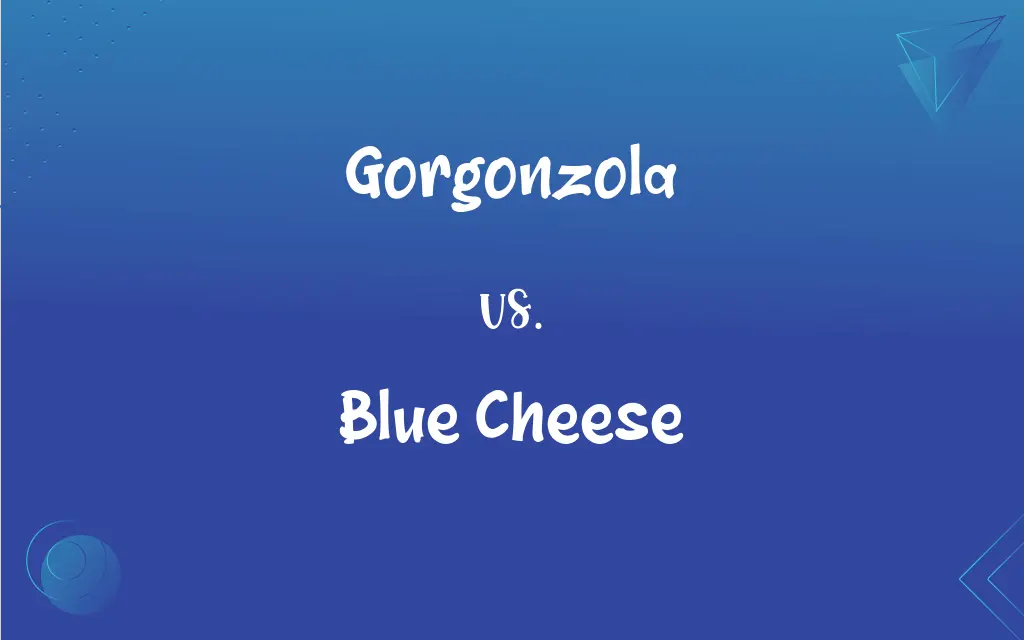Gorgonzola vs. Blue Cheese: What's the Difference?
Edited by Aimie Carlson || By Harlon Moss || Updated on October 5, 2023
Gorgonzola is a specific type of Italian blue cheese, while blue cheese is a general category of cheeses cultured with Penicillium, creating a characteristic blue veining.

Key Differences
Gorgonzola, known for its rich, creamy consistency and distinct veining, emanates from Italy, showcasing a unique profile of flavors. In comparison, blue cheese, while similarly veined, can be varied, hailing from various countries and adopting multiple flavor profiles.
Gorgonzola generally presents two main variants: Gorgonzola Dolce, which is soft and sweet, and Gorgonzola Piccante, offering a firmer texture and sharper taste. Blue cheese, with its broad category, can exhibit a spectrum of textures and flavors, spanning from creamy to crumbly and mild to sharp.
The creation of Gorgonzola involves specific processes, primarily using unskimmed cow’s milk, and features a distinct production methodology in Italy. Blue cheese, conversely, may be made from cow, goat, or sheep’s milk, and its production methods can differ widely across types and regions.
Gorgonzola carries PDO status, meaning it’s production is regionally protected and must adhere to traditional methods. Blue cheese, conversely, can be crafted worldwide and while specific variants (like Roquefort) have protective status, the overall category does not.
Culinary applications for Gorgonzola often lean into its luxurious, melt-in-the-mouth quality, enhancing dishes like risotto and pasta. Whereas blue cheese, with its diverse range, finds its way into various culinary contexts, from salad dressings to being crumbled atop steaks.
ADVERTISEMENT
Comparison Chart
Origin
Italy
Various countries
Variants
Mainly two (Dolce and Piccante)
Numerous
Milk Type
Primarily cow’s milk
Cow, goat, or sheep’s milk
Protected Status
PDO (Protected Designation of Origin)
Some types (e.g., Roquefort), not all
Typical Applications
Pasta, risotto
Various, including salads and burgers
ADVERTISEMENT
Gorgonzola and Blue Cheese Definitions
Gorgonzola
Gorgonzola is a specific Italian blue cheese known for its creamy texture.
The pasta was enriched with a gorgonzola sauce, providing a lush, velvety experience.
Blue Cheese
Blue cheese refers to cheeses developed with cultures of the mold Penicillium, creating blue veins or spots.
The blue cheese crumbles added a punchy, bold flavor to the fresh salad.
Gorgonzola
Gorgonzola can be enjoyed in two primary forms: the milder Dolce and the sharper Piccante.
She preferred Gorgonzola Dolce for its sweet, mild character in her dishes.
Blue Cheese
It can be made from various types of milk, including cow, sheep, and goat, influencing its flavor profile.
The sheep’s milk blue cheese offered a rich, nutty flavor distinct from its cow’s milk counterparts.
Gorgonzola
Gorgonzola features a distinct blue veining, a result of being cultured with Penicillium.
The gorgonzola showcased its characteristic blue veins, indicative of its rich, deep flavor.
Blue Cheese
Encompassing a wide variety, blue cheese can hail from numerous countries, each with unique characteristics.
Whether French, English, or Italian, blue cheese always brings a piquant flair to the table.
Gorgonzola
Gorgonzola is often utilized in Italian cuisine, enhancing both savory and sweet applications.
He adorned the fig and gorgonzola pizza with a balsamic glaze, harmonizing sweetness with savory depth.
Blue Cheese
Blue cheese can vary significantly in texture, from creamy and spreadable to firm and crumbly.
She spread the creamy blue cheese onto the crusty bread, enjoying each flavorful bite.
Gorgonzola
Originating from Northern Italy, Gorgonzola carries a protected status, ensuring regional authenticity.
Authentic gorgonzola cheese must be produced in specific regions of Italy to ensure quality.
Blue Cheese
Blue cheese finds diverse culinary uses, being featured in salads, burgers, and even desserts.
The steak was topped with a generous portion of blue cheese, elevating its savory profile.
Gorgonzola
A pungent, blue-veined Italian cheese with a soft, crumbly texture, made of cow's milk.
Gorgonzola
A blue-veined Italian cheese, made from cow's milk.
Gorgonzola
A kind of Italian pressed milk cheese; - so called from a village near Milan.
Gorgonzola
Italian blue cheese
FAQs
Where does blue cheese originate from?
Blue cheese can originate from various countries, including France, England, and Italy, among others.
Can blue cheese be eaten melted?
Yes, blue cheese can be melted and is often used in sauces, on pizzas, and in various hot dishes.
Can gorgonzola be used in salad dressings?
Yes, gorgonzola is often used to create rich, creamy salad dressings.
How should gorgonzola be stored?
Gorgonzola should be stored in the refrigerator, wrapped in foil to preserve its moisture and prevent it from absorbing other flavors.
Is it safe to eat the mold in blue cheese?
Yes, the mold in blue cheese is safe to eat and is intentionally developed during the cheese-making process to provide its characteristic flavor and veining.
What is gorgonzola cheese made from?
Gorgonzola is made primarily from unskimmed cow’s milk.
What is the characteristic flavor of gorgonzola?
Gorgonzola typically offers a rich and creamy or sharp and firm flavor, depending on the variant (Dolce or Piccante).
Can blue cheese be made from different types of milk?
Yes, blue cheese can be made from cow, sheep, or goat’s milk.
Can blue cheese be produced anywhere?
While certain specific blue cheeses have origin protections, blue cheese as a category can be produced worldwide.
Does blue cheese need to be refrigerated?
Yes, blue cheese should be stored in the refrigerator to maintain its quality and prevent excessive molding.
What are the main types of gorgonzola?
Gorgonzola mainly comes in two types: Dolce (sweet and creamy) and Piccante (sharp and crumbly).
Is gorgonzola cheese always produced in Italy?
Authentic gorgonzola cheese is traditionally produced in specific regions of Italy and has PDO status.
Is blue cheese a good source of nutrition?
Blue cheese can be a good source of calcium, protein, and other nutrients, but also tends to be high in sodium and fat.
Can gorgonzola be used in dessert recipes?
Yes, gorgonzola, especially the Dolce variety, can be used in various desserts due to its sweet and creamy profile.
Is blue cheese suitable for vegetarian diets?
Some blue cheeses are vegetarian-friendly, but it depends on the specific type and brand as some may use animal rennet.
How many types of blue cheese are there?
There are numerous types of blue cheese, including but not limited to Roquefort, Stilton, and Gorgonzola.
What dishes is gorgonzola commonly used in?
Gorgonzola is often used in pasta, risotto, salads, and sometimes even in desserts.
Is gorgonzola a type of blue cheese?
Yes, gorgonzola is a specific type of Italian blue cheese.
Does blue cheese always taste the same?
No, blue cheese can exhibit a wide range of flavors, from mild and creamy to sharp and tangy, depending on the type and aging process.
Is gorgonzola suitable for lactose-intolerant individuals?
Gorgonzola does contain lactose, so it may not be suitable for individuals with lactose intolerance.
About Author
Written by
Harlon MossHarlon is a seasoned quality moderator and accomplished content writer for Difference Wiki. An alumnus of the prestigious University of California, he earned his degree in Computer Science. Leveraging his academic background, Harlon brings a meticulous and informed perspective to his work, ensuring content accuracy and excellence.
Edited by
Aimie CarlsonAimie Carlson, holding a master's degree in English literature, is a fervent English language enthusiast. She lends her writing talents to Difference Wiki, a prominent website that specializes in comparisons, offering readers insightful analyses that both captivate and inform.
































































